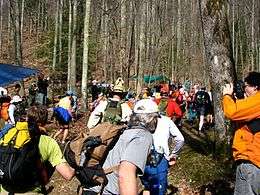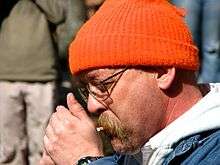Barkley Marathons

The Barkley Marathons is an ultramarathon trail race held in Frozen Head State Park near Wartburg, Tennessee. Runners may elect a "fun run" of 60 miles (97 km) or the full course of 100 miles (160 km) (distances are approximate). The race is run over a 60-hour period in late March or early April of each year.
History
The Barkley course was designed by Gary "Lazarus Lake" Cantrell. His idea for the race was inspired upon hearing about the 1977 escape of James Earl Ray, the assassin of Martin Luther King, Jr, from nearby Brushy Mountain State Penitentiary. Ray covered only 8 miles (13 km) after running 55 hours in the woods. Cantrell said to himself, "I could do at least 100 miles", chiding Ray's low mileage. Thus, the Barkley Marathons was born.[1] Cantrell named the race for his longtime neighbor and running companion, Bill Barkley.[2]
Race description
Registration
The Barkley is limited to 40 runners, and usually fills up quickly the day registration opens. Requirements and times to submit an entry application are a closely guarded secret, with no details advertised publicly. Potential entrants must complete an essay on "Why I Should be Allowed to Run in the Barkley", pay a $1.60 application fee, and complete other requirements subject to change. If accepted, an entrant receives a "letter of condolence".
Course
The course itself, which has changed distance, route, and elevation many times since its inaugural run in 1986, currently consists of a 20-mile (32 km) unmarked loop with no aid stations except water at two points along the route and the runner's parked car at the beginning of the loop. Runners of the 100-mile version run this loop five times, running loops two and four in darkness, taking a counterclockwise direction for loops three and four, followed by each runner alternating direction on loop five, after the first-placed runner's choice. Runners of the 60-mile "fun run" complete three circuits of the loop.
With 54,200 feet (16,500 m) of accumulated vertical climb, the 100-mile run is considered to be one of the more challenging ultramarathons held in the United States, if not the world.[3] In some years, no one has completed the entire course.[4]
The 100-mile and 60-mile distances are nominal. While a minimum of 20 miles, the length of the loop varies due to changes in the course. Some say the loop is as long as 26 miles (42 km), yielding 130 miles (210 km) for the full race and 78 miles (126 km) for the "fun run".[5][6]
Timing and other requirements

The Barkley starts any time from midnight to noon on race day, with one hour till race start signaled by blowing a conch. The race officially begins when a cigarette is lit by the race director.[5][7]
In addition to running, competitors must find between nine and eleven books along the course (the exact number varies each year) and remove the page corresponding to the runner's race number from each book as proof of completion.[8] Competitors get a new race number, and thus a new page requirement, at the start of each lap.
The cut-off time for the 100-mile race is 12 hours per loop, and the cut-off for the 60-mile version of the race is 40 hours overall, which averages out to approximately 13 hours and 20 minutes per loop. Out of about 800 starts, the 100-mile race has been completed within the official 60-hour cut-off 17 times by 14 runners. In 2006 nobody finished even the 60-mile "fun run" in under 40 hours. The best women's achievement is Sue Johnston's 66 miles (106 km) in 2001. More than 30 competitors failed to reach the first book (two miles).[9][2]
Finishers
The full, five-loop race has been completed 17 times by 14 runners.
| Year | Name | Time | Notes |
|---|---|---|---|
| 1995 | Mark Williams | 59:28:48 | new record |
| 2001 | David Horton | 58:21:00 | new record |
| Blake Wood | 58:21:01 | ||
| 2003 | Ted "Cave Dog" Keizer | 56:57:52 | new record |
| 2004 | Mike Tilden | 57:25:18 | |
| Jim Nelson | 57:28:25 | ||
| 2008 | Brian Robinson | 55:42:27 | new record |
| 2009 | Andrew Thompson | 57:37:19 | |
| 2010 | Jonathan Basham | 59:18:44 | |
| 2011 | Brett Maune (1) | 57:13:33 | |
| 2012 | Brett Maune (2) | 52:03:08 | current record |
| Jared Campbell (1) | 56:00:16 | ||
| John Fegyveresi | 59:41:21 | ||
| 2013 | Nick Hollon | 57:39:24 | |
| Travis Wildeboer | 58:41:45 | ||
| 2014 | Jared Campbell (2) | 57:53:20 | |
| 2016 | Jared Campbell (3) | 59:32:30 |
Documentary
The 2012 Barkley was covered in a full-length documentary titled The Barkley Marathons: The Race That Eats Its Young, directed by Annika Iltis and Timothy Kane.
References
- ↑ Jamison, Neal (April 30, 2014). Running Through the Wall: Personal Encounters With the Ultramarathon. Breakaway Books.
- 1 2 Everett, Matthew (April 13, 2011). "The Barkley Marathons Is the Toughest Race You've Never Heard Of". Metro Pulse. Archived from the original on August 25, 2011. Retrieved March 30, 2012.
- ↑ Seminara, Dave (March 27, 2013). "The Barkley Marathons: Few Know How to Enter; Fewer Finish". The New York Times. ISSN 0362-4331. Retrieved April 3, 2016.
- ↑ Buteau, Michael. "All 40 Runners Fail at 100-Mile Tennessee Mountain Race". Bloomberg.com. Retrieved April 3, 2016.
- 1 2 Engle, Charlie (May 2011). "Notorious". Runner's World. Retrieved April 3, 2016.
- ↑ Everett, Matthew (April 6, 2016). "A Record-Setting Weekend at the Barkley Marathons, the Race That Eats Its Young". Knoxville Mercury. Retrieved April 6, 2016.
- ↑ Annika Iltis, Timothy James Kane (directors) (2014). The Barkley Marathons: The Race That Eats Its Young.
- ↑ Ethier, David (July 5, 2013). "An Ultramarathon You Can't Finish". Huckberry. Retrieved April 3, 2016.
- ↑ Jhung, Lisa (April 6, 2010). "The Impervious Barkley Marathons". Runner's World. Retrieved April 4, 2012.
Further reading
Furtaw, Ed. (2010) Tales From Out There: The Barkley Marathons, The World's Toughest Trail Race, CreateSpace. ISBN 1-4505-4701-X
External links
- Matt Mahoney's Barkley Marathons Site
- The Believer magazine article - "The Immortal Horizon"
- "Out There" at the Barkley: Portraits From the Edge of Endurance
- "Barkley 100" documentary short film by Brendan Young
- Metro Pulse Article
- "The Barkley Marathons: The Race That Eats Its Young" Feature Length Documentary Film
- "Tales From Out There: The Barkley Marathons, The World's Toughest Trail Race"